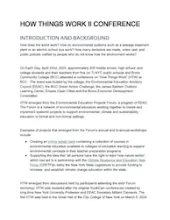HOW THINGS WORK II CONFERENCE
INTRODUCTION AND BACKGROUND
How does the world work? How do environmental systems such as a sewage treatment plant or an electric school bus work? How many decisions are made, votes cast, and public policies crafted by people who do not know how the environment works?
On Earth Day, April 22nd, 2025, approximately 200 middle school, high school, and college students and their teachers from six NYC public schools and Bronx Community College (BCC) attended a conference on “How Things Work” (HTW) at BCC. The event was hosted by the college, the Environmental Education Advisory Council (EEAC), the BCC Green Action Challenge, the James Baldwin Outdoor Learning Center, Empire Clean Cities and the Bronx Economic Development Corporation.
HTW emerged from the Environmental Education Projects Forum, a program of EEAC. The Forum is a network of environmental educators working together to create and implement systemic projects to support environmental, climate and sustainability education in formal and non-formal settings.
Examples of projects that emerged from the Forum’s annual and bi-annual workshops include:
- Creating an online syllabi bank containing a collection of courses in environmental education available to colleges of education wanting to expand environmental concepts in their teacher preparation programs.
- Supporting the idea that “all persons have the right to learn how nature works,” which has led to a partnership with the Climate Resilience and Education Task Force (CRETF) to lobby the New York State Legislature to provide funding to increase and establish climate change education within the state.
HTW emerged from discussions held by participants attending the sixth Forum workshop. HTW was modeled after the original YouthCaN conferences created by long-time New York University Professor and EEAC Secretary Millard Clements. The first HTW was held in the Great Hall of the City College of New York on March 5, 2024.
To offer the project to a geographically representative sample of New York City’s youth, HTW ll was held in the Bronx on the beautiful campus of Bronx Community College (BCC). Students came from IS 313, Mott Haven Community School, and Fannie Lou Hamer Freedom High School in the Bronx, John Dewey High School in Brooklyn and BCC. Sixteen exhibits staffed by 40 expert environmental educators from fourteen organizations engaged the youth in demonstrations, discussions and hands-on activities that were rich and deep as both the students and the educators asked probing questions.
The conference began with brief talks in the auditorium of the Gould Memorial Library by Ray Pultinas of EEAC and the James Baldwin Outdoor Learning Center, BCC student Milton Baquedano and Elena Perez, Director of the BCC Green Action Challenge. The highlight of Milton’s presentation was his description of his work in India where he helped build seven weather stations across the country. For two consecutive years Milton had traveled to India with a group led by science professors Neal Phillip and Paramita Sen to do climate change research. Milton is a pre-med student with a focus on neuroscience. All attendees then moved to Colston Hall to interact with the exhibits.
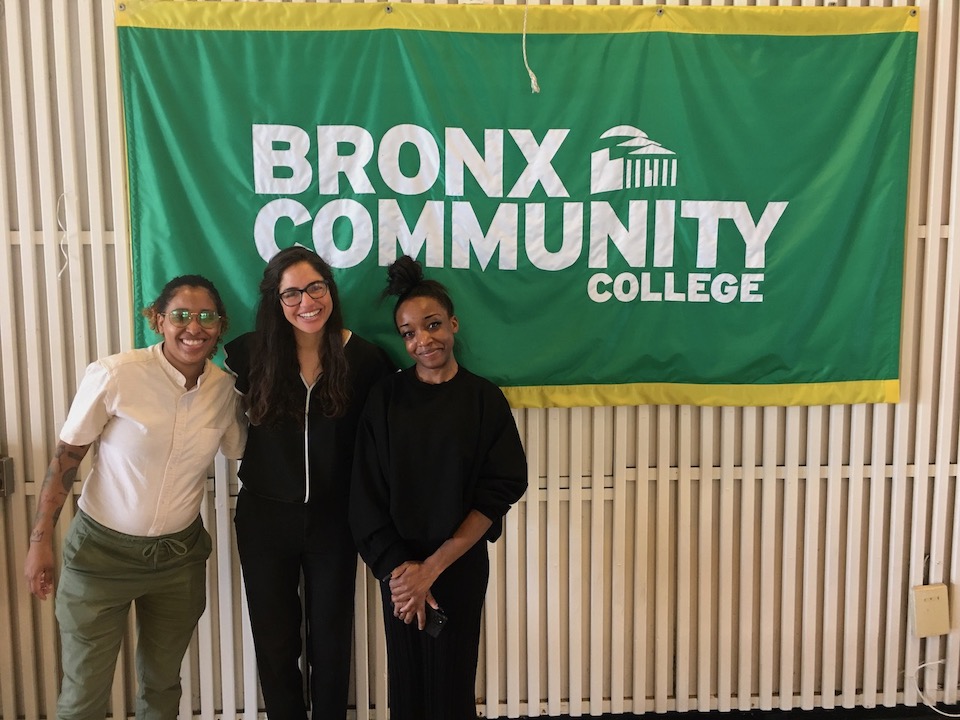
HOW THINGS WORK — THE EXHIBITS
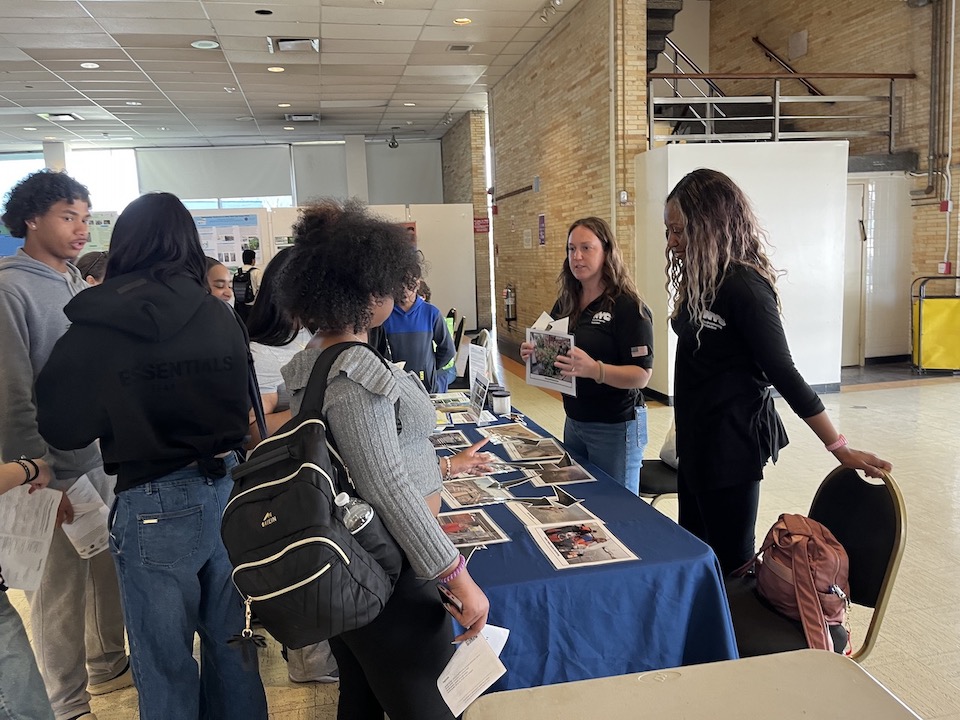
New York City Department of Environmental Protection: How A Wastewater Treatment System Works
Over nine million people in NYC and Westchester County receive about one billion gallons of water daily from 19 reservoirs east and west of the Hudson River in the Croton, Catskill and Delaware Watersheds. Water ultimately travels to our homes through aqueducts and tunnels by the force of gravity.
DEP’s exhibit demonstrated what happens to water after we use it. Students learned that wastewater travels from our homes into sewers and then into one of 14 wastewater treatment plants where it is treated with primary (physical) and secondary (biological) treatment that together remove about 90% of the bacterial and viral content. Most of the remaining pathogens are killed by chlorination disinfection before the effluent is released into the waters around the city. The waters are at that point “fishable and swimmable” but not drinkable.
DEP staff also covered why combined sewer overflows occur during and after heavy rainfall. Stormwater runoff can sometimes overwhelm the wastewater treatment system thus releasing untreated water into the waters surrounding the city. Curbside rain gardens and other more absorbent landscape features as well as reducing water use during rain events are designed to prevent harbor water pollution and the cessation of water related activities.
Contact: Robin Sanchez, SanchezR@dep.nyc.gov
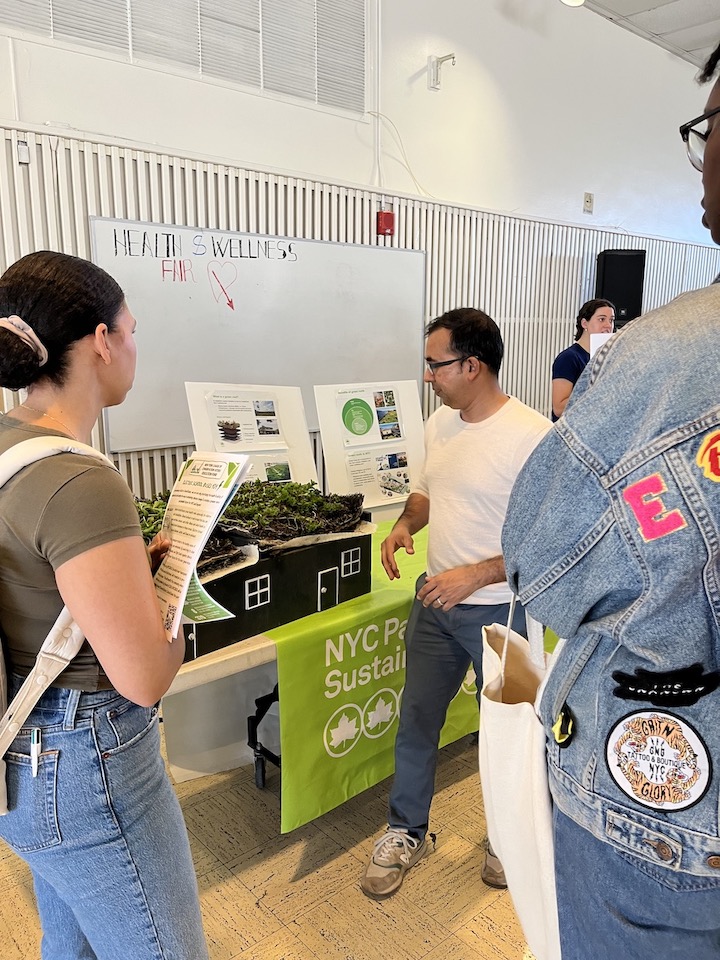
New York City Department of Parks and Recreation: How A Green Roof Works
Utilizing a realistic replica of a green roof replete with actual soil and plants, staff from Parks’ Sustainable Facilities were able to help youth observe and feel the impact of a green roof. The roof absorbs rainfall helping plants to grow and preventing runoff onto the streets below and into the sewer system.
The green roof system cools buildings in warmer weather and prevents combined sewer overflows by helping to reduce untreated sewage entering coastal waters during and after heavy rainfalls.
The exhibitors described four types of green roofs: extensive, pre-planted with shallow soil depth containing moss, herbs and grasses requiring minimal maintenance; intensive, planted with deep soil depth with a wide range of plants requiring regular maintenance; modular, a green roof structured in trays and mats that contain plant and water retention material; and monolithic, a roof membrane in one layer, e.g., a silicone roof coating system.
Contact: sustainableparks@parks.nyc.gov
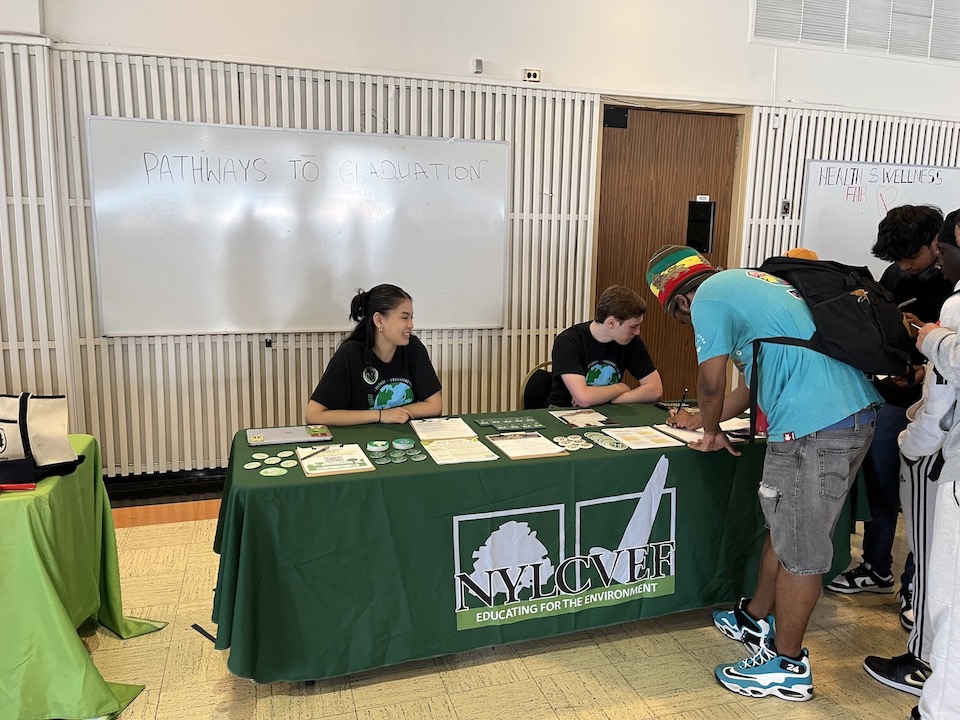
New York League of Conservation Voters Education Fund and NYCSBUS: How an Electric School Bus Works
Electric school buses significantly decrease greenhouse gas emissions compared to traditional diesel buses. Electric school buses use a battery pack to store electrical energy that powers the drive motor. Batteries are charged by plugging the bus into an electric power source. They can further combat climate change by utilizing renewable energy sources for charging the batteries.
Modern electric school buses have ranges of 100–300 miles per charge. Electric school buses operate effectively in extremely cold climates thanks to advanced battery thermal management systems.
Youth were able to observe an electric bus that was placed on campus during the conference and discuss its operation with a NYCSBUS driver/educator.
The Zerega Depot run by NYCSBUS, located near Hunts Point, the most polluted area in the Bronx, will transition to zero-emission electric buses. This will benefit the community where asthma is very common. (New York League of Conservation Voters Education Fund fact sheet).
Contact: 202-785-8683; feedback@lcevf.org
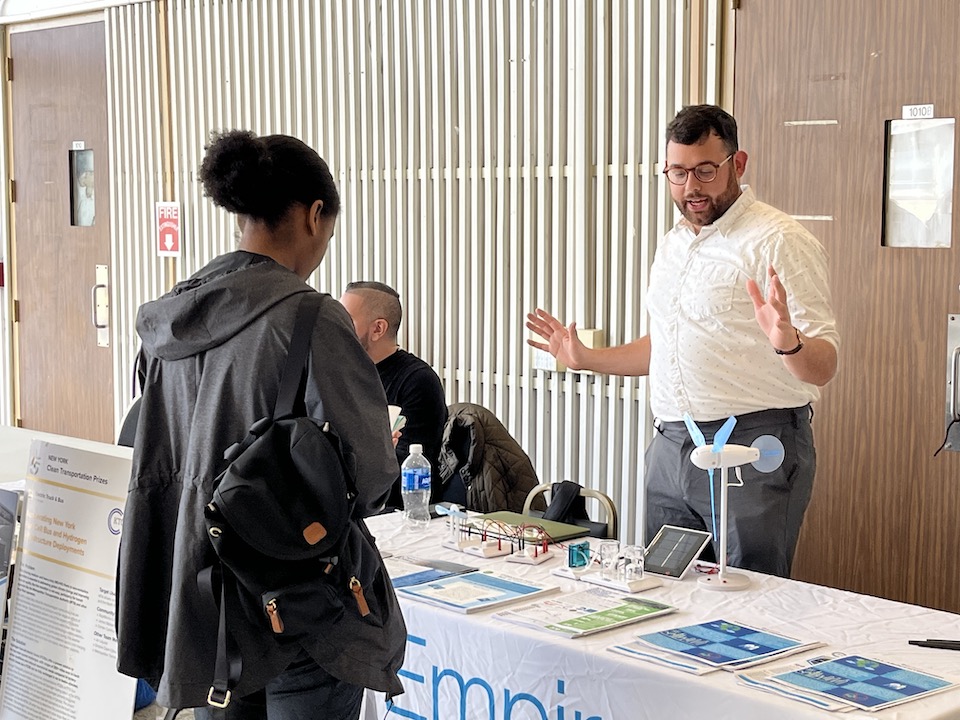
Empire Clean Cities: How a Hydrogen Fuel Cell Bus Works
Hydrogen fuel cells generate electricity by reacting hydrogen and oxygen in the presence of a platinum catalyst, the byproduct of which is water. The catalyst separates hydrogen molecules into protons and electrons. The electrons go through an external circuit, creating a flow of electricity. This electricity is used as the power source for an electric motor which drives the wheels of the bus.
The exhibit featured demonstrations and educational materials about how hydrogen fuel cell buses work and the benefits of this type of vehicular transportation. The hydrogen fuel cell bus is a new type of zero emissions vehicle technology.
Through a grant from the New York State Energy Research and Development Authority two hydrogen fuel cell buses will be deployed on eight bus routes in the Bronx. The buses will be supported by a new hydrogen fueling station at the MTA’s Gun Hill Depot. The buses will save 50,000 gallons of diesel fuel per year, meaning less local air pollution in the Bronx.
(Source: Empire Clean Cities)
Contact: Empire Clean Cities (empirecleancities.org), (212) 839-7728
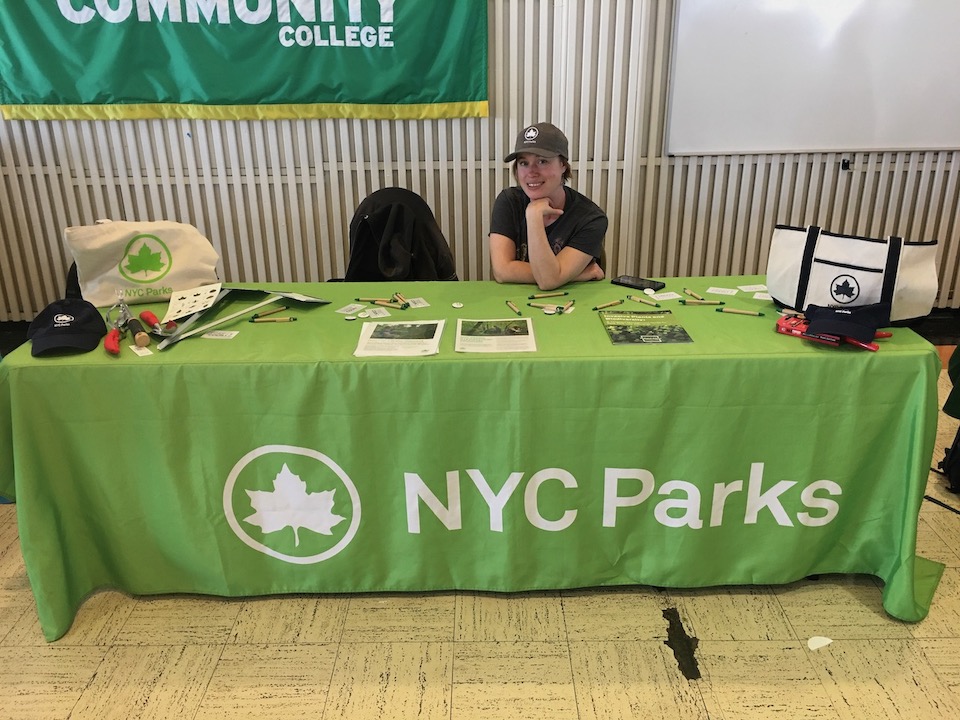
NYC Parks Stewardship Program: How Does Habitat Restoration and Erosion Control Work
The exhibit reviewed how school and community groups volunteer with the stewardship program to preserve and restore forests and wetlands, build and improve trails and care for trees.
They learn that planting native species in a forest area in a NYC park provides all the benefits of trees to all the organisms in a habitat and holds the soil in place during rainfall preventing runoff of pollutants into streams, ponds and local coastal waters thereby preserving water quality.
When planting vegetation and removing litter in wetland areas participants become aware of how wetlands prevent flooding and remove pollutants and debris from streams tributary to coastal waters.
Mulching street trees allows rainwater to be captured in tree pits, helping trees to thrive and halting runoff onto streets and into sewers.
Contact: stewardship@parks.nyc.gov
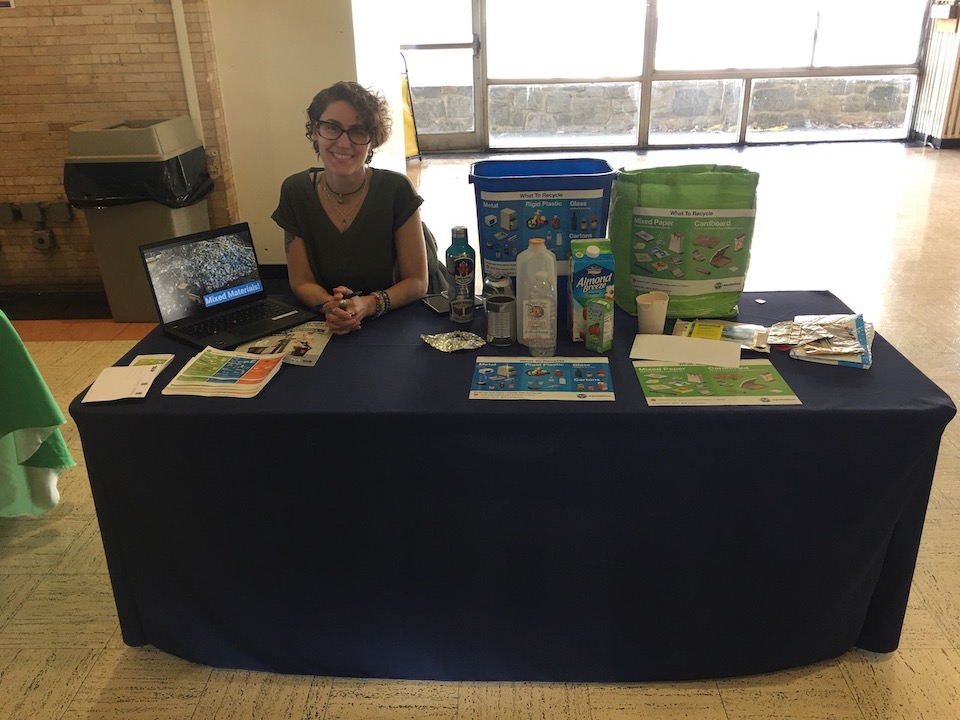
SMR/Balcones Recycling: How Does Recycling in NYC Schools and Homes Work
The exhibit included a sorting activity which demonstrated what is and isn’t recyclable. Participants learned where their recyclables go and ideas for reducing and reusing the materials they use.
The 2,000 tons of daily garbage that is recycled is collected by the NYC Department of Sanitation. Vibrating machines separate cardboard and paper. Different types of paper are sorted by hand and baled. Paper is then loaded onto a barge and transported to the recycling plant run by Pratt Industries on Staten Island. Paper is processed into pulp. After the pulping process is completed in about three hours the finished product is a 25 ton roll of paper. More than 1,000 tons of recycled paper are created each day.
Remaining recyclables at the DOS facility continue onto a conveyer which uses magnets to remove steel cans. Different types of plastics are identified and separated using optical scanners. Metal, glass, plastic and cartons are taken to the Sunset Park Materials Recovery Facility in Brooklyn. New York City identifies vendors who will pay to obtain the paper and metal materials and a small percentage of the plastics.
Contact: https://www.balconesrecycling.com/location/recycling-and-shredding-services-in-brooklyn-new-york/
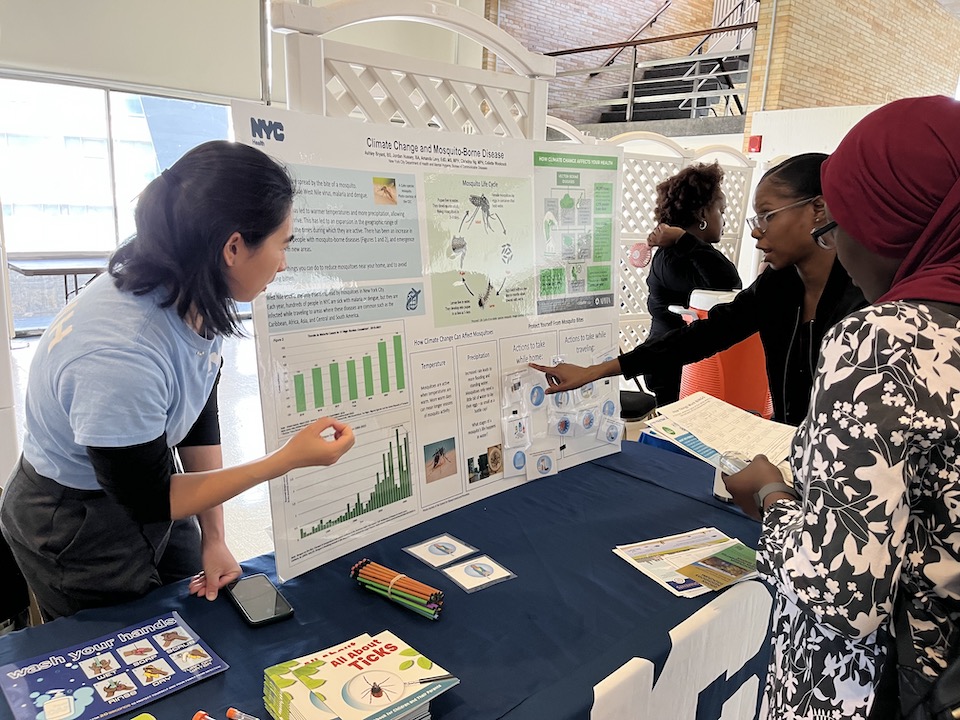
NYC Department of Health and Mental Hygiene (DOH): How Climate Change Contributes to Mosquito-Borne Disease in NYC, How Diseases are Transmitted by Mosquitoes and How Disease Can be Prevented
Agency scientists demonstrated to students how climate change can lead to an increase in infectious diseases transmitted by mosquito and tick bites such as Lyme disease or West Nile virus. These diseases may spread to previously unaffected areas as warmer temperatures provide more advantageous conditions for mosquitoes and ticks to live.
Students also learned aspects of tick identification and removal and about the interventions which can prevent the transmission of disease such as wearing long sleeves, applying mosquito repellent, removing standing water sources and vaccinating against vector borne diseases when traveling outside of the United States.
Contact: Christina Ng, cng1@health.nyc.gov
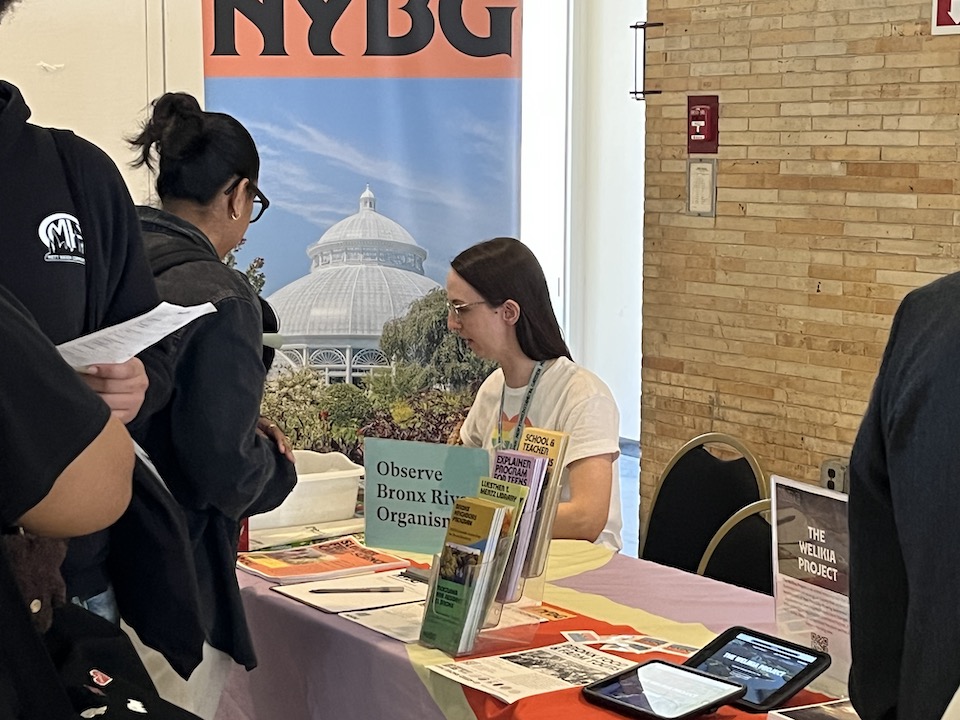
New York Botanical Garden (NYBG): *How are Community Gardens in the South Bronx Building Spaces for Healing and Education While Leading the Fight Against Toxic Pollution; *How do Plants Along the Bronx River Protect Water Quality
NYBG staff from the Bronx Green-Up Program discussed with students how community gardens can help shield South Bronx inhabitants, both physically and emotionally, from the harmful impacts of toxic pollutants. They also reviewed how plants hold soil in place during precipitation events helping to prevent erosion and preserve water quality. Gardens too, can absorb rainwater and reduce runoff into sewage treatment plants helping to forestall combined sewer overflows.
Contact: NYBG Bronx Green-Up (nybg.org/gardens/bronx-green-up), (718) 817-8700
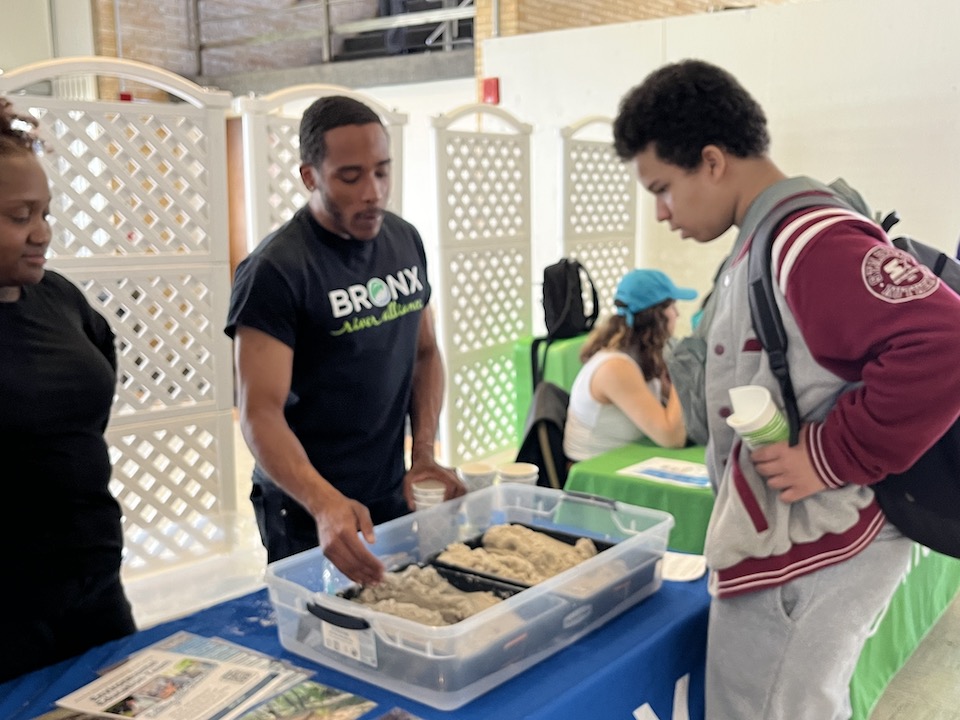
Bronx River Alliance: What is the Impact of Erosion on the River and What is the Difference Between Erosion and Weathering
The Alliance staff involved youth in activities and discussions that demonstrated that erosion is the movement of sediment or rocks that have been broken down. Weathering is the process of decomposing, breaking down or color changing of rocks.
In erosion, sediment, finely broken-down rocks, soil and sand, is deposited on beaches, estuaries, sandbars, deltas and lagoons.
Planting trees and other vegetation along the river helps hold soil in place, prevent erosion and preserve water quality.
Contact: info@bronxriver.org, (718) 542-4124
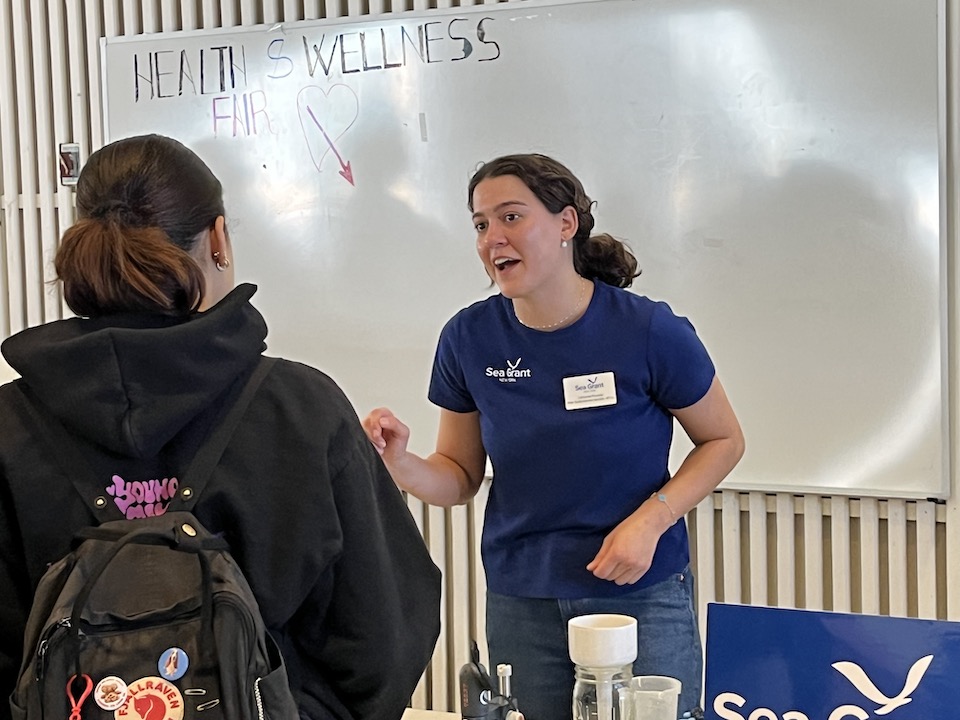
Sea Grant New York: How Can Microfiber Pollution Be Reduced?
Chemicals are used in the production of clothing, which can be released into the environment after extended exposure. Clothing sheds tiny pieces of fiber called microfibers. Microfibers are the biggest source of microplastic pollution in our environment. Researchers have found microfibers in air, water, soil, food and humans.
Friction from wearing and drying clothes releases microfibers into the air. Synthetic fibers like polyester, nylon, spandex and acrylic last a long time in the environment. Microfibers shed into laundry wastewater. Wastewater treatment systems trap most microfibers in sludge, a byproduct of sewage treatment, but some microfibers leak into waterways. Sludge can be used as fertilizer, introducing microfibers into soil. Rain washes microfibers into waterways. Humans inhale and ingest microfibers. Possible negative health effects are being investigated.
Research led by Columbia University is developing advanced laundry filtration technology to capture fibers before they pollute the environment.
We can reduce microfiber pollution by washing clothes less. Clothes can look newer for longer by washing them in cold water and air drying. This will reduce the need to buy more clothes. Checking clothing tags can help us avoid clothing with synthetic fibers like polyester, acrylic and nylon.
Washing machine microfiber filters are being developed. Some are available for purchase, including built-in, retrofit, and washing bag and ball options. (Source: Sea Grant New York fact sheet)
Contact: Catherine Prunella, Water Quality Extension Specialist, New York Sea Grant - Cornell University, cjp@cornell.edu, (718) 502-8092, seagrant.sunysb.edu
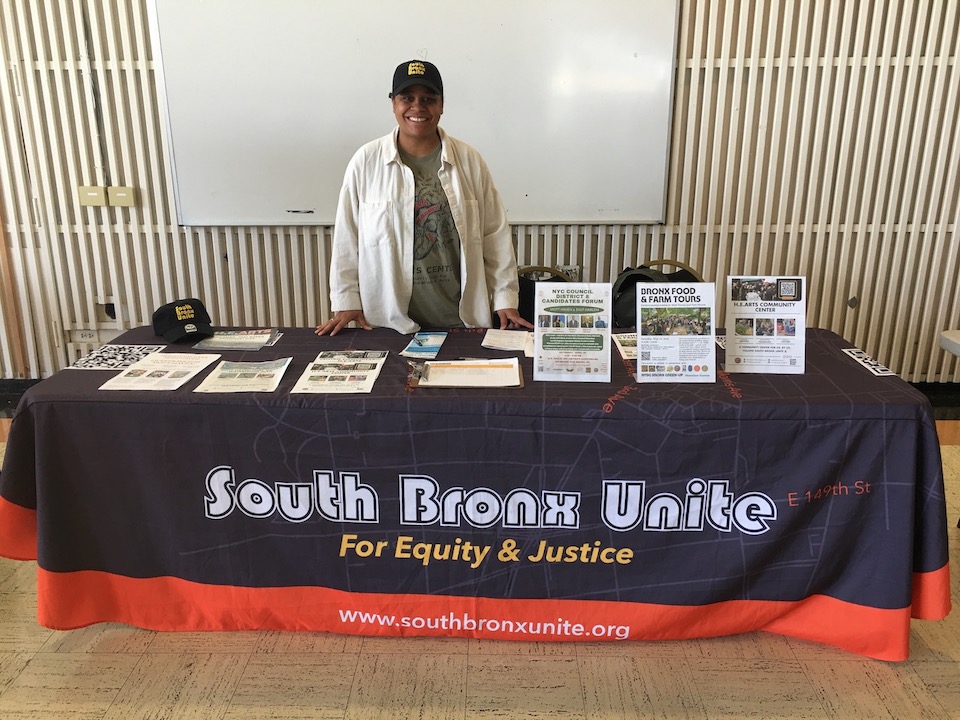
South Bronx United: How Can the Mott Haven Community Work to Make Air Quality, Housing and Land use Better for Its Inhabitants
South Bronx United is advocating for cleaner air in Mott Haven, which has the worst air pollution in New York State and among the highest asthma rates in the nation, by installing air monitors across the neighborhood. They are working to prevent gentrification and demanding that 100% of new housing be truly affordable to the average family in the area. They have created the Mott Haven-Port Morris Community Land Stewards to advocate for an accessible waterfront, more green spaces and a new community center: the HEArts Center (Health, Education and the Arts).
The Mott Haven-Port Morris Waterfront Plan would:
- Create a network of connected open green spaces and access to the waterfront; Help produce clean air in this disproportionately pollution burdened community; Address pollution related illnesses and create better health outcomes; Protect the community from river flooding as they are in a high-risk flood zone; Allow the community to manage the waterfront green spaces and determine how they are used, centering local priorities and increasing empowerment for generations. (South Bronx Unite fact sheet).
Contact: southbronxunite.org
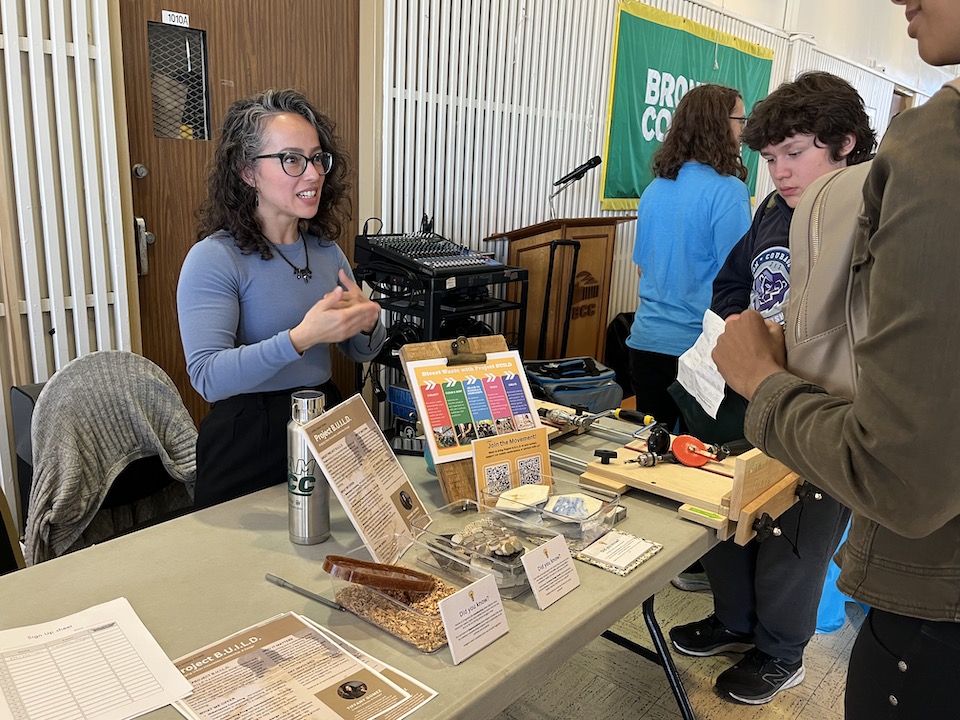
Project Build: How to Create Modular, Accessible Makerspaces
In education, a makerspace is a place that provides hands-on, creative ways for students to design, experiment and invent as they engage a variety of tools and technology. Project Build is a sustainable design initiative and consultancy helping schools and communities create modular, accessible makerspaces where none currently exist. Through hands-on woodworking and workforce development programs, Project Build connects educators and learners to real world resources, reclaimed materials and design centered education that fosters creativity, environmental responsibility and practical skill building.
An important aspect of this process is waste diversion—collecting, cleaning and sorting reclaimed materials, tools and supplies and delivering them to schools, youth programs and community-based organizations. (Source: Project Build Fact Sheet)
Contact: Tiffany Gomez, Creative Director and Founder, gomezdesignstudio.com
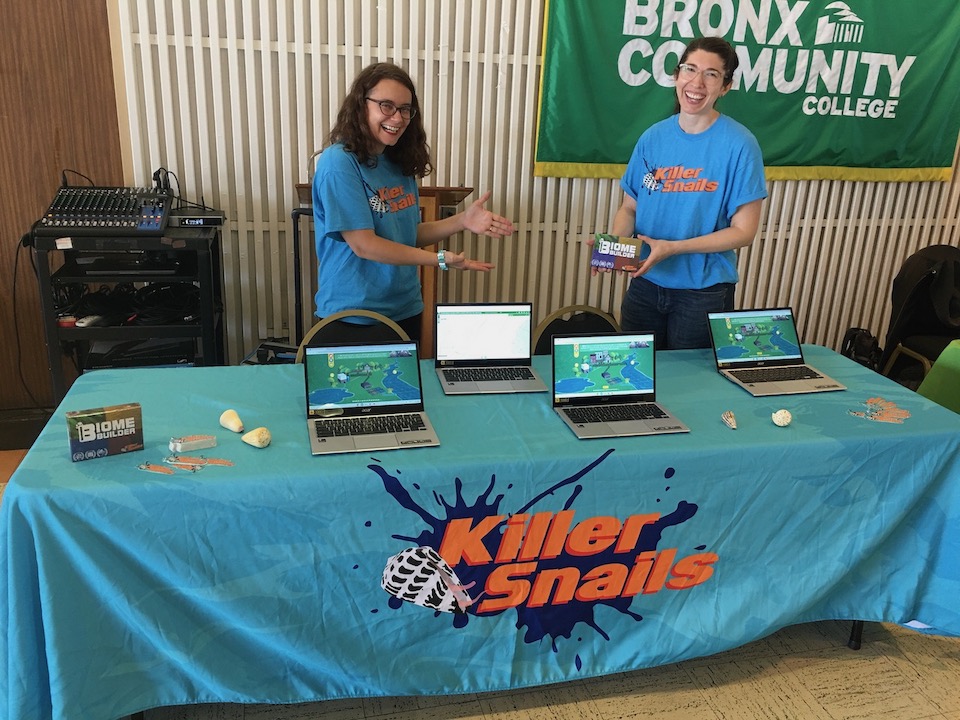
National Institutes of Health Venom Colab/Killer Snails: How Does Venom from Venomous Organisms Such as Marine Snails, Snakes, Sea Anemones or Scorpions Work to Provide Potential Treatment for Health Problems Including Pain, Cancer, Clotting or Autoimmune Diseases
This exhibit involved students and teachers in learning about the Venom Colab, an inquiry-based collaborative science experience for 6th–9th grade students. Over 5 class periods, students take on roles as scientists and work together to study venom. Each group of youth studies a venomous organism like marine snails, snakes, sea anemones or scorpions to find peptides or proteins from venom as potential treatment for health problems including pain, cancer, clotting or autoimmune diseases.
Students serve in one of four roles: zoologist, biochemist, molecular biologist and pharmacologist. Each role performs distinct tasks using personalized websites and augmented reality or webVR on a computer or tablet before bringing their findings to a collaborative lab meeting where students work together toward their goal of developing new medicine. (Source: Venom Colab/Killer Snails fact sheet, National Institutes of Health)
Contact: killersnails.com

Brotherhood Sister Sol: How Does Hot Box Composting Work
Hot box composting locks in heat and cooks compost. Inside the hot aerobic composting bin, the temperature lies between 104–140°F. The temperature is monitored with two thermometers, one buried in compost, one for the lid. The process is reliant upon supplying plenty of oxygen to the decomposition process and the promotion of necessary bacterial activity to break down waste into compost.
The hot bin is often manufactured from expanded polypropylene which is chosen for its insulation properties. It retains heat for longer and keeps bacteria working effectively.
Contact: info@brotherhood-sistersol.org, 212-283-7044, brotherhood-sistersol.org
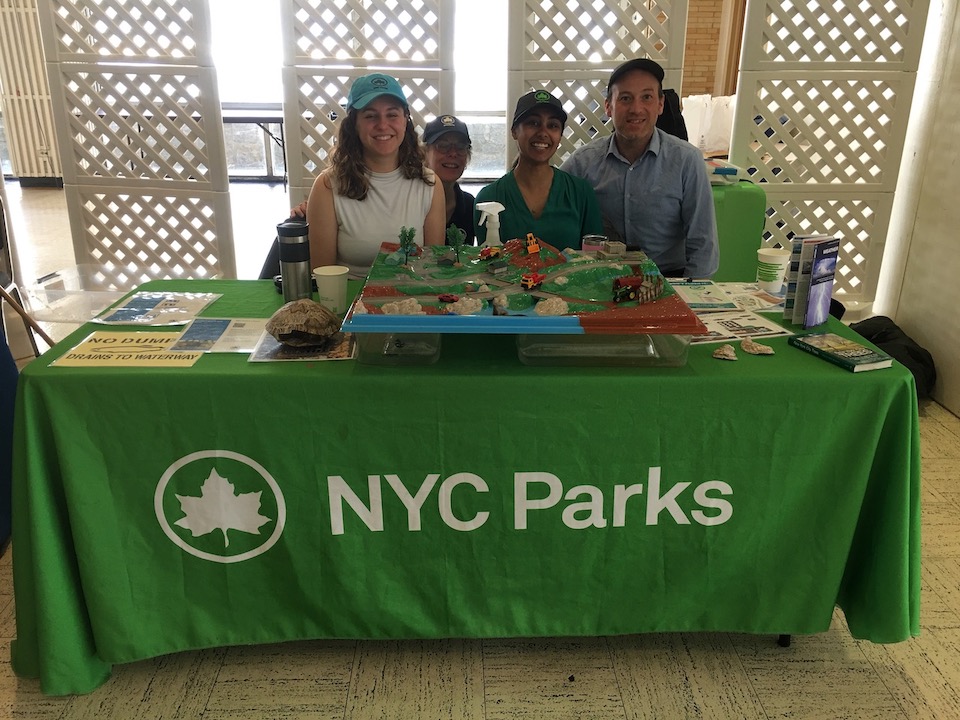
New York City Department of Parks and Recreation: How Does Runoff Enter Our Lands and Waters and How Can We Manage It
Parks staff used the model shown in the photo to teach students how all kinds of waste, from regular garbage to toxic chemicals, is deposited by individuals and industries into our ecosystem and then carried by precipitation into our coastal land areas and waters.
Contact: nycgovparks.org
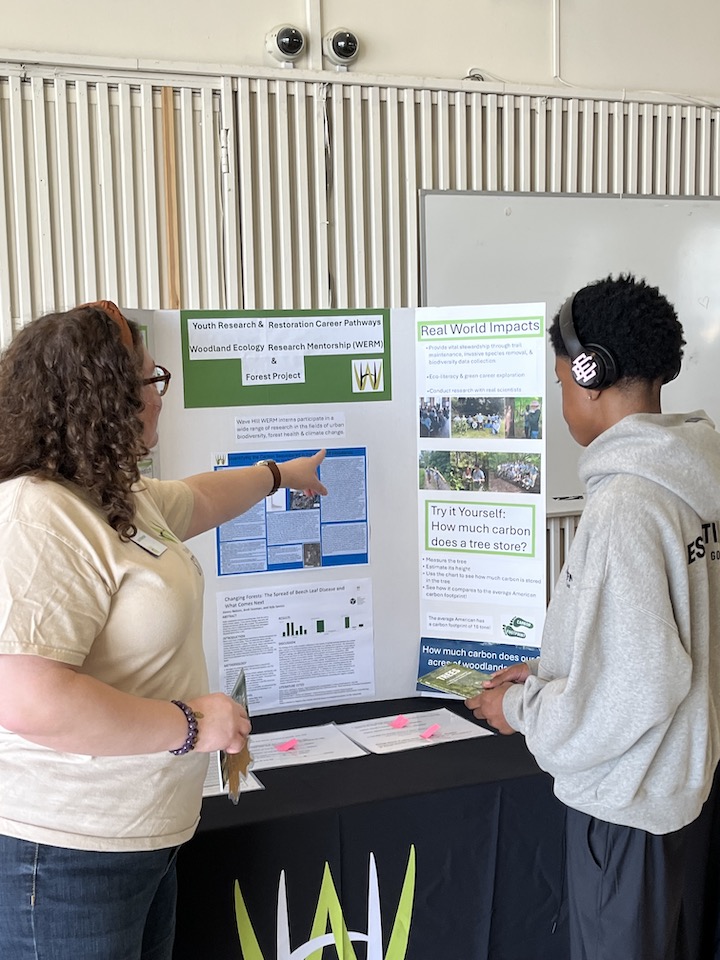
Wavehill: How Can Youth Learn About Urban Biodiversity, Forest Health and Climate Change
The exhibit covered Wave Hill’s Youth Research and Restoration Career Pathways, Woodland Ecology Restoration Mentorship and Forest Project Initiatives. The exhibit included a panel on how to determine how much carbon is stored in a tree by taking appropriate measurements.
Contact: Ilana Weinstein, Youth Programs Manager, Ilana.Weinstein@wavehill.org, wavehill.org
Bronx Community College Poster Exhibits in Collaboration with Other CUNY Schools
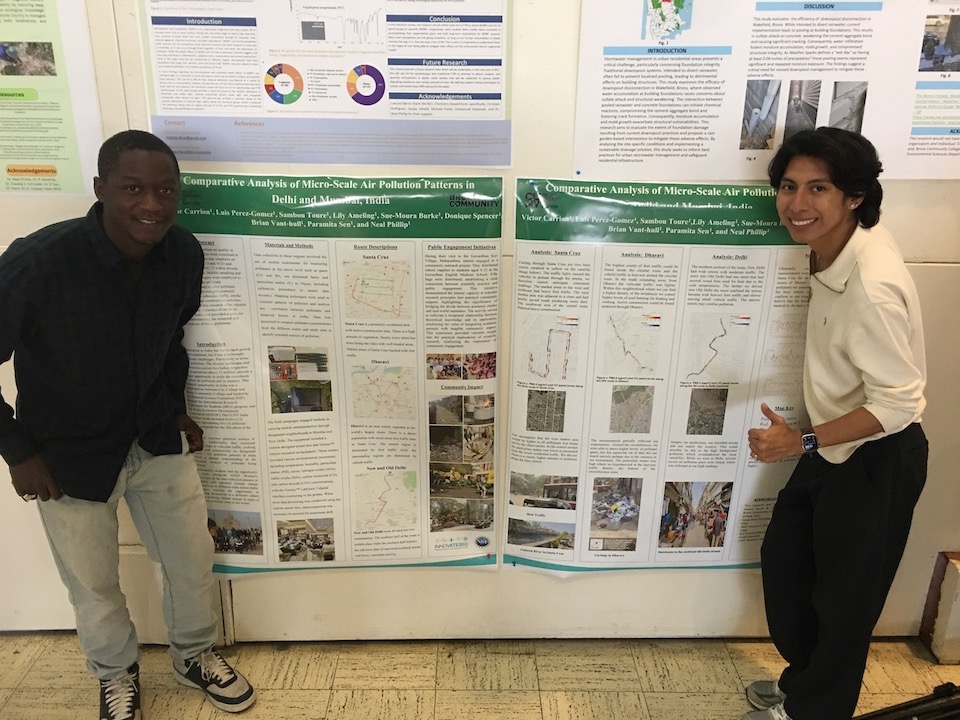
How to Conduct Comparative Analysis of Micro-Scale Air Pollution Patterns in Urban Areas - Delhi and Mumbai, India
The complexities of urban air quality were examined with particular emphasis on gaseous pollutants (CO and SO2) and particulate matter (PM2.5). Mobile sampling and mapping methodologies were employed to discuss variations in pollutant concentrations, analyze inter-pollutant correlations and investigate potential associations with vehicular traffic, smoke from cooking and construction activities. The results indicated that while some local areas did exhibit the level of pollution hypothesized by the researchers, others did not pointing towards the need to measure a number of variables related to air quality, for example wind velocity and direction.
Contact: Neal.Phillip@bcc.cuny.edu
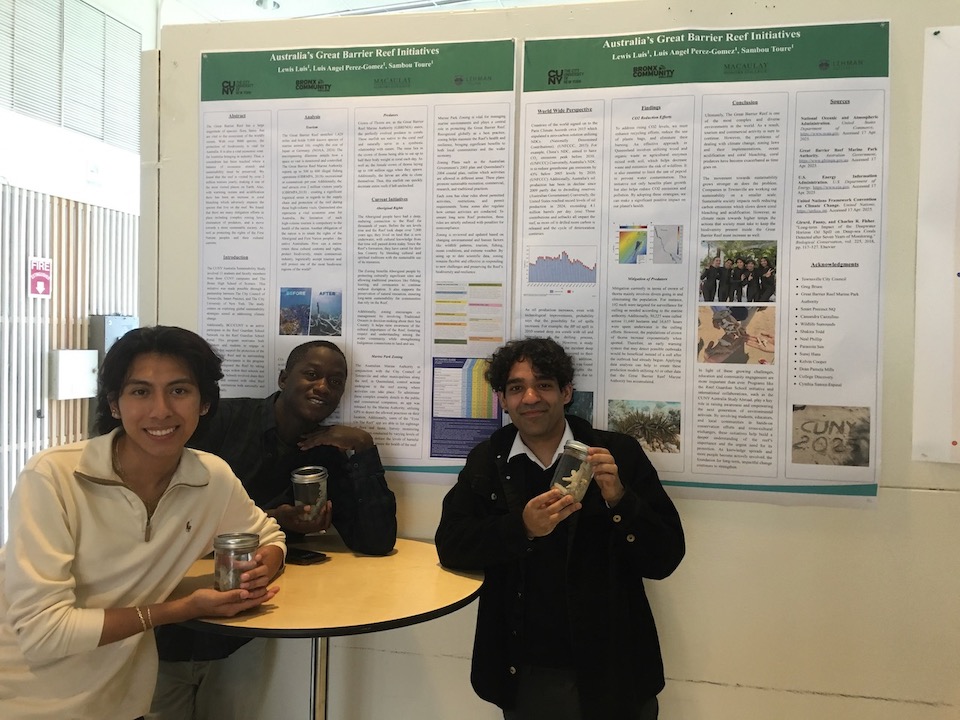
Australia’s Great Barrier Reef Initiative: How to Preserve Biodiversity on the Reef
The exhibit, done by Bronx Community College in collaboration with other units of the CUNY system—Lehman College and the Macaulay Honors College, pointed to various ways biodiversity can be preserved on the reef: improving the quality of water flowing to the reef, supporting world leading reef management, accelerating the development of restoration and adaptation measures to help the reef adapt to climate change such as planting nursery-grown corals back onto the reef and empowering people to care for the reef through strong partnerships and collaboration.
Contact: Neal.Phillip@bcc.cuny.edu
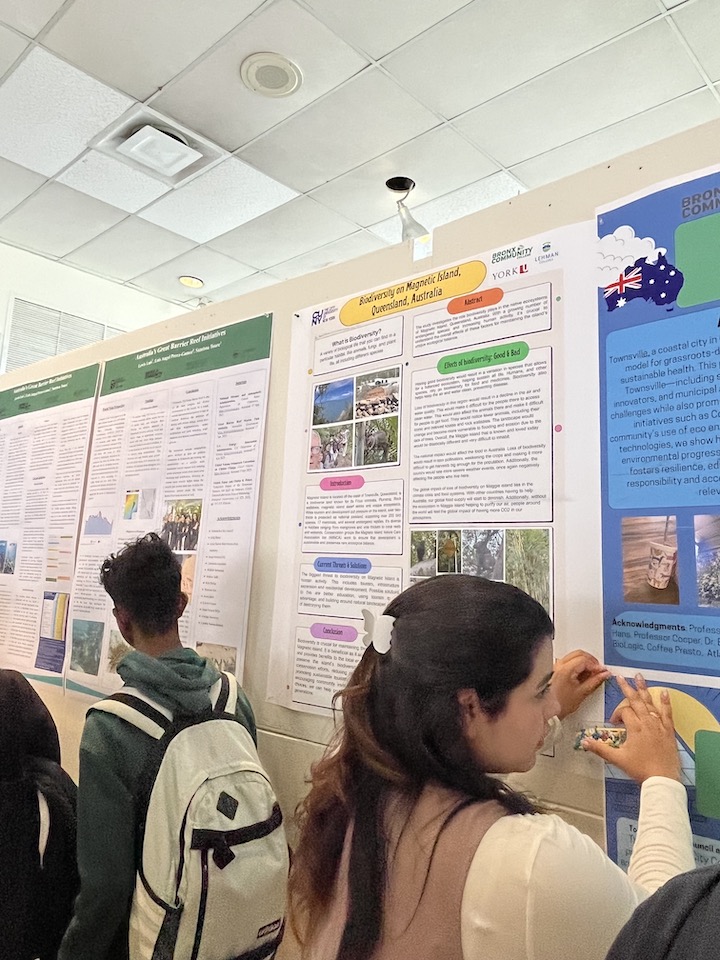
How Biodiversity Can Be Maintained on Magnetic Island, Queensland, Australia
Biodiversity is crucial for maintaining the health and balance of ecosystems on the island. Biodiversity supports the survival of plants and animals and provides benefits to the local environment. To preserve biodiversity, we must support conservation efforts, reduce pollution, minimize habitat destruction, build habitat through activities like planting native species and promote sustainable tourism.
Contact: Paramita.Sen@bcc.cuny.edu
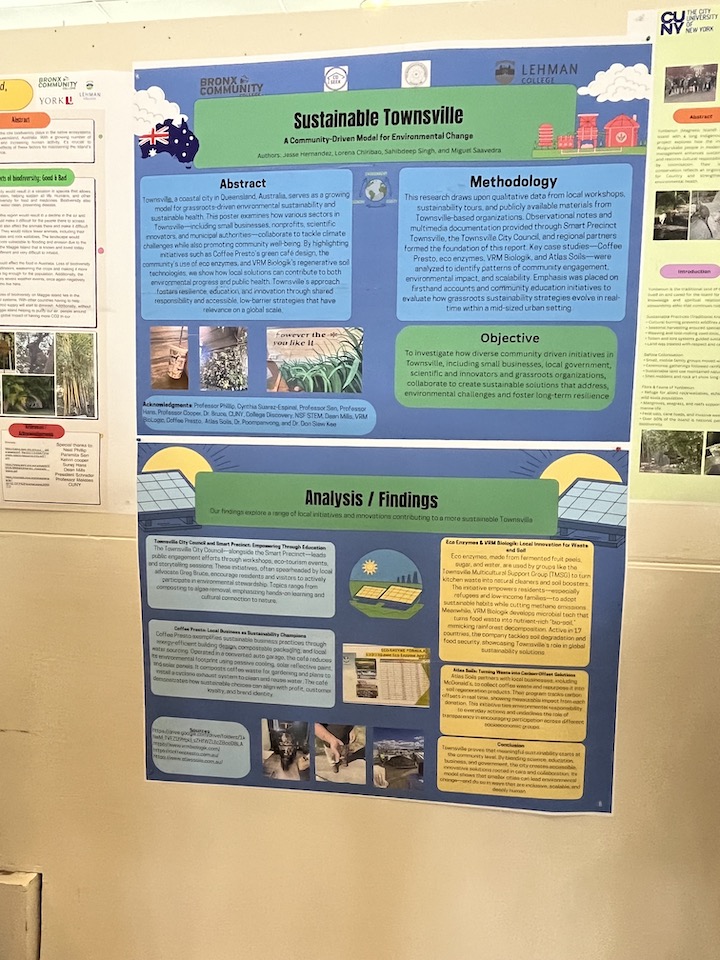
Sustainable Township - A Community Driven Model for Environmental Change: How Sustainability Can Help a Town Work
Townsville, a coastal city in Queensland, Australia is a growing model for grassroots driven environmental sustainability. It depends on all sectors—small business, nonprofits, scientific innovators and municipal authorities collaborating to tackle climate related issues. Green cafe design, commercial use of eco enzymes and regenerative soil technology promote environmental progress and public health.
Eco enzymes made from fermented fruit peels, sugar and water are used by groups like the Townsville Multicultural Support Group to turn kitchen waste into natural cleaners and soil boosters. The process empowers residents to adopt sustainable habits while cutting methane emissions. Meanwhile VRM Biologik develops microbial tech that turns food waste into nutrient rich bio-soil.
Contact: Neal.Phillip@bcc.cuny.edu, Paramita.Sen@bcc.cuny.edu
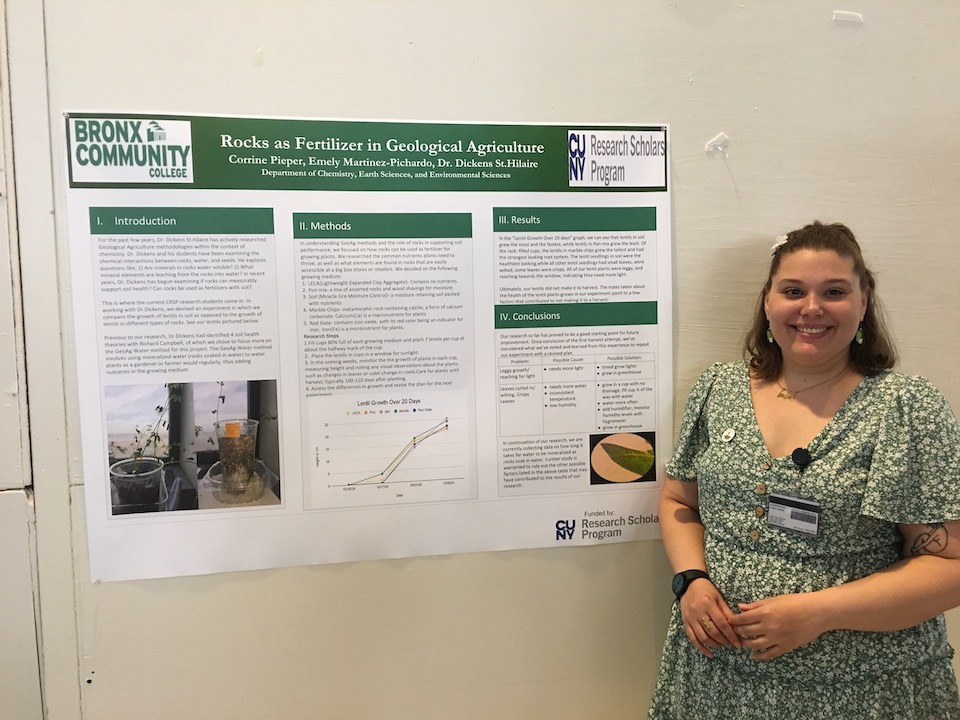
Can Rocks Function as Fertilizer in Geological Agriculture
The growth of lentils in soil was compared to the growth of lentils in different types of rocks. Using the Geo Ag Water Method, which involves using mineralized water (rocks soaked in water) to water plants, as a gardener or farmer would, and adding minerals to the growing medium.
Over 20 days lentils in soil grew the most and fastest and were the healthiest looking while the lentils in marble chips (metamorphic rock containing calcite) grew the tallest and had the strongest looking root system. A control mix of assorted rocks and wood shavings grew the least. However, none of the lentils made it to harvest, possibly due to overall experimental conditions such as too little light, inconsistent temperature, low humidity, and too little water. More research needs to be done under improved conditions.
Contact: Neal.Phillip@bcc.cuny.edu, Paramita.Sen@bcc.cuny.edu
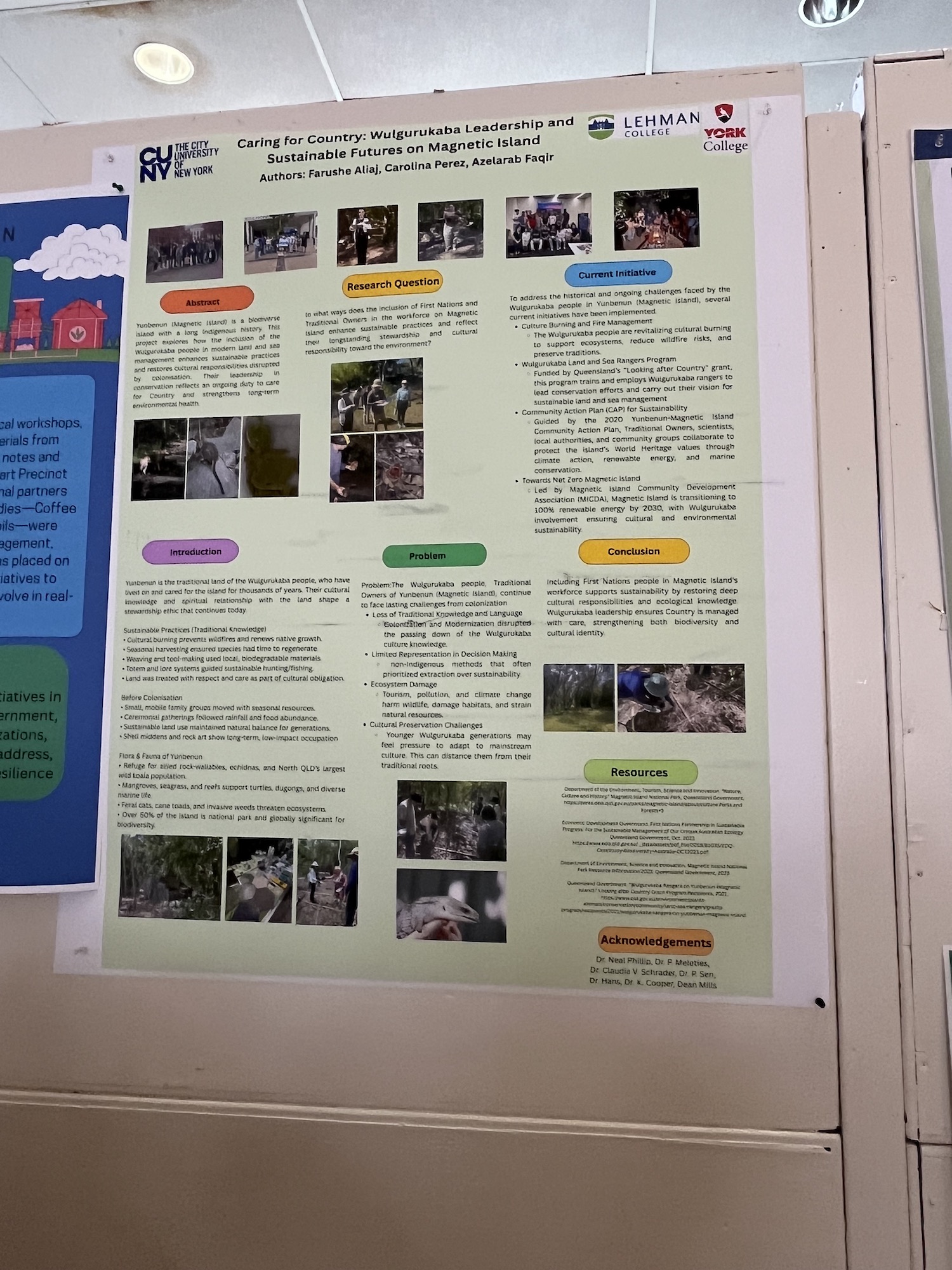
How Modern Land and Sea Management by the Wulgurukaba People Enhances Sustainable Practices on Magnetic Island
Current Initiatives:
- Cultural Burning and Fire Management - Revitalizing cultural burning to support ecosystems, reduce wildfire risks and preserve traditions.
- Wulgurukaba Land and Sea Rangers Program - Employs rangers to lead conservation efforts and carry out their vision for sustainable land and sea management.
- Community Action Plan for Sustainability - Traditional owners, scientists, local authorities and community groups collaborate to protect the Island’s World Heritage values through climate action, renewable energy and marine conservation.
- Towards Net Zero Magnetic Island - The Island is transitioning to 100% renewable energy by 2030.
Contact: Neal.Phillip@bcc.cuny.edu
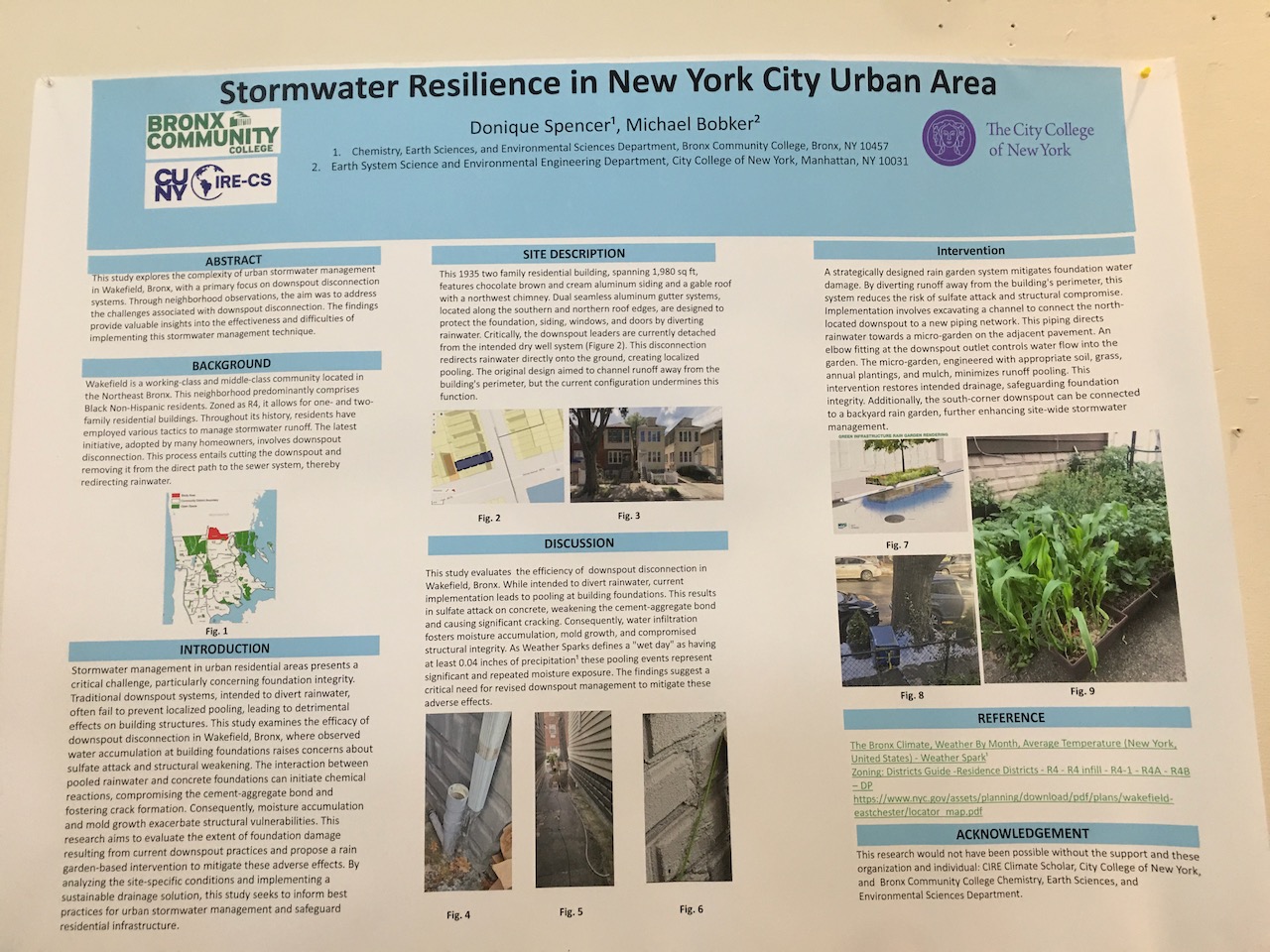
How to Develop Stormwater Resilience in a New York City Urban Area
Focused on the Wakefield community in the Northeast Bronx, the project demonstrates that a strategically designed rain garden system mitigates foundation water damage caused by stormwater runoff management systems that cut the downspout (pipe for carrying rainwater from a rain gutter) and remove it from the direct path to the sewer system, thereby redirecting rainwater.
By diverting runoff away from the building’s perimeter, the rain garden system reduces the risk of sulfate attack and structural compromise and minimizes runoff pooling.
Contact: Neal.Phillip@bcc.cuny.edu, Paramita.Sen@bcc.cuny.edu
EVALUATION
Evaluation questionnaires were sent to participating teachers and exhibitors. This is a summary of the responses with specific comments included.
The responses were extremely positive with respect to direct learning by students and overall emotional connection to the exhibits. Some sample responses:
From a Bronx Community College Teacher:
“Having my students hear the experience of a fellow student who carried out several research projects outside the U.S. was motivational for me and my students who saw themselves in him. It was also revealing to know what Project Director Elena Perez and her team is for.”
From a Bronx Community College Student:
“I had a better insight into how hydrogen is employed in running electric buses of the MTA and the potential for extending it to NYC school buses. This is a great idea for reducing our carbon footprint.”
From a NYC Public School Teacher:
“My biggest takeaways were how my students made connections with what we had learned in class with the vendors, such as the different forms of erosion, the water cycle and the 3 R’s of waste management: reduce, reuse, recycle.”
From Another Public School Teacher:
“We were enthused to see the stewardship efforts of the Bronx River Alliance so we’ll do a water testing project. The students liked the miniature composting structure too. We’ll be exploring the possibility of acquiring one so that we could have a real demo. at our school. Others also liked the green roofs and their effect on the environment. And we all loved the Hall of Fame area as well.”
From Nine of the Exhibitors:
“The students were great. They stopped for 5-10 minutes and seemed to enjoy the learning. Students were very interested in our table. K-12 seemed more interested in the BINGO Card while college students were more interested in the information we were discussing. The table sizes were great and big enough for us to talk to multiple groups at a time.”
‘“I suggest that next time the period for exhibitions be prolonged a bit more because owing to time constraints interactions (at the tables) had to be curtailed prematurely."
“The BINGO cards were a great idea. It was a great way to get the students to engage with each table.”
(The students participated in a BINGO Card activity that allowed them to take what they were learning from each exhibitor table and connect it to prompts on a BINGO Card. Those who completed the card were entered into a drawing of prizes from the exhibitors and other partners).
“We could have used more time for students to engage—its a lot of tables. Students probably could have benefited from an explanation of the BINGO Card. Some were trying to write an entire paragraph into the square. It was a great idea; kids could have benefited from a notes sheet they could answer questions from and take home.”
“Structure of the day went really smoothly. Setup and breakdown were both very quick and easy for us.”
I think there were different age groups and education levels. Each group is taught differently. It was nice to practice my skills.”
Big direction signs should be posted outside and inside of Colston Hall for better navigation to the event area.”
“‘Having lunch was great, thanks for providing. It turns out you could search Colston Hall on Google maps and it would take us right there. Maybe in the email you could add the Google maps link.”
“I like that we were able to support students locally in the Bronx. It was amazing to see the research opportunity for them to learn about concepts in the environmental sciences. Looking forward to potentially exhibiting again next year.”
The conference organizing committee consisted of many people who were responsible for the planning and implementation of this significant program. Special recognition goes to Bethany Kogut and Robin Sanchez from EEAC and Elena Perez from the Bronx Community College Green Action Challenge for their leadership, hard work and dedication. The team members included the following:
Environmental Education Advisory Council (EEAC)
Bethany Kogut
Amanda Levy
Ray Pultinas
Robin Sanchez
Mike Zamm
David Chernack, Empire Clean Cities
Richard Wooley, James Baldwin Outdoor Learning Center
Bronx Community College
Eddy Bayardelle
Madelaine Centeno
Richard Ginsberg
Emily Marino
Ana Mendieta
Elena Perez
Neal Phillip
Barbara Thomson
Paramita Sen
Report prepared by Mike Zamm, EEAC

